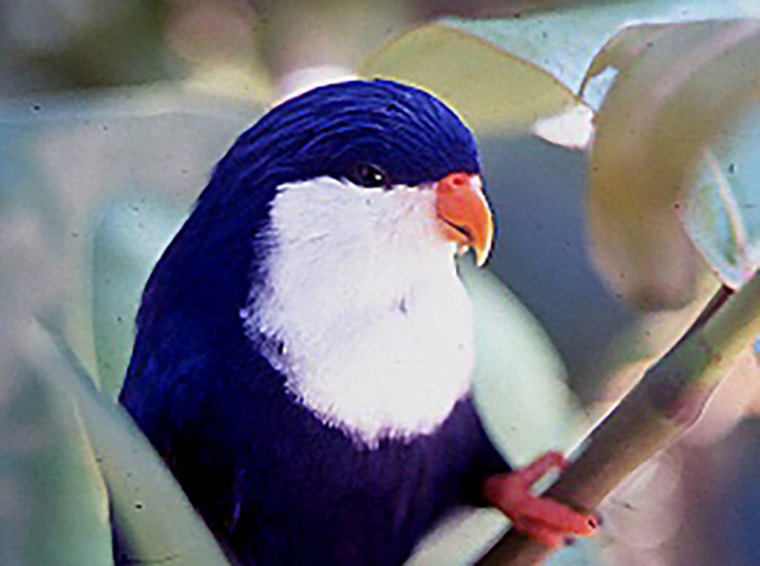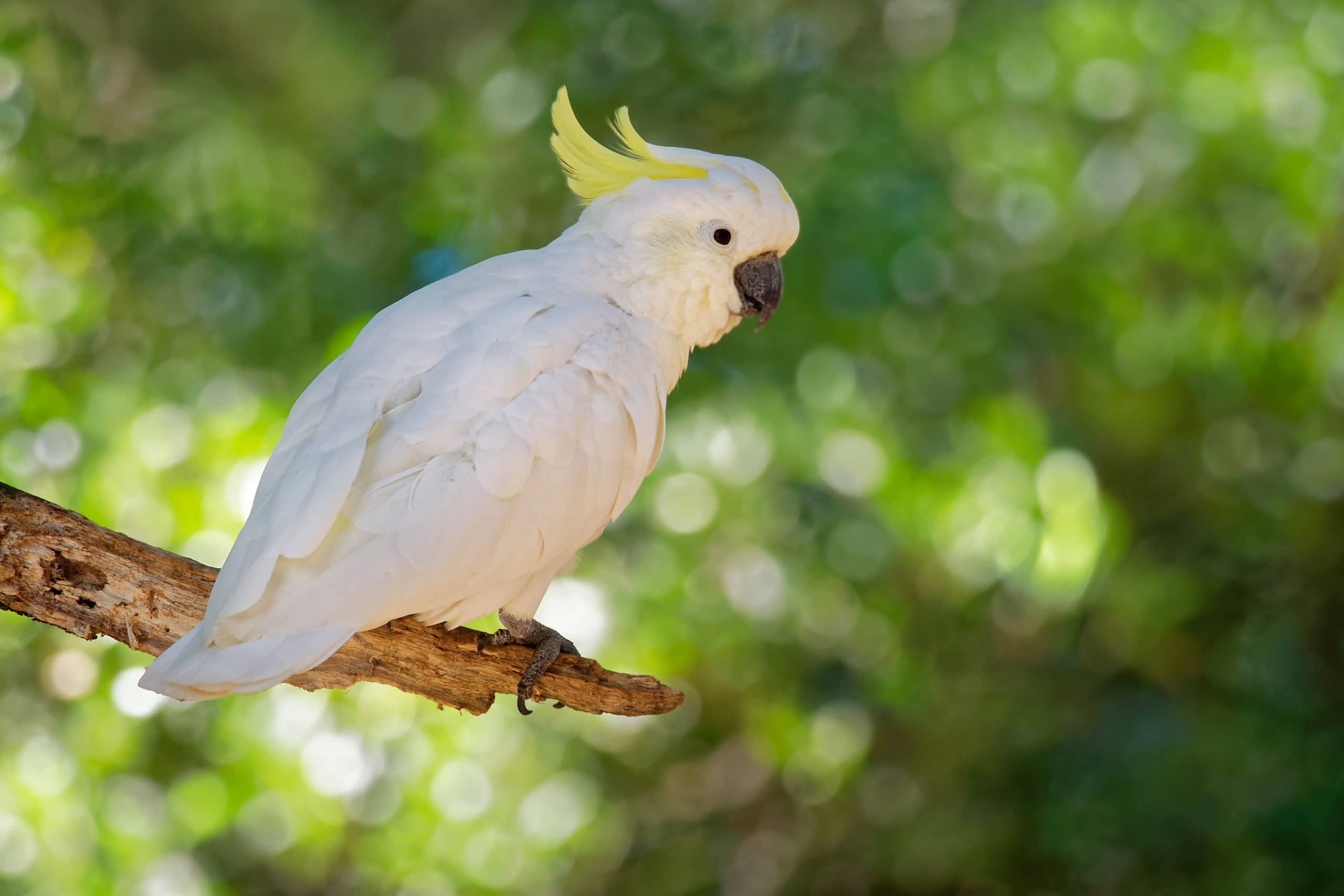
Lorikeets themselves are considered the clowns of the parrot world and the blue lorikeet is no exception. The orange beak of this species certainly contributes to that assumption. The blue lorikeet is considered to be engendered in the wild because of predators that have been introduced into its habitat along with increasingly worsening storms.
They tend to make good pets, so if you’re considering keeping one, keep reading below for a little on the blue lorikeet’s personality, what you need to feed him, and a care guide to get you started.
Blue Lorikeet Overview
| Common Names: | Blue Lorikeet, Violet Lorikeet, Tahitian Lori, Blue Lori, Nunbird, Indigo Lori |
| Scientific Name: | Vini peruviana |
| Adult Size: | 18 cm |
| Life Expectancy: | 10 years in the wild, 20 years in captivity |
Origin and History
The blue lorikeet is native to the Cook Islands and French Polynesia. At one time, this lovable bird was found on at least 23 islands in Tahiti. Today, however, it’s found on about eight islands, including Motu and possibly Harvey.
These birds can be found in wooded areas and in coconut plantations and gardens that have plenty of bananas and mango trees.
As previously mentioned, the blue lorikeet is considered to be endangered1, so if you are lucky enough to get one as a pet bird, make sure to care for it properly and with love, affection, and patience.
Temperament
The blue lorikeet can become aggressive when it comes to toys or items that he sees to be his. They also tend to get upset if they feel their territory is being encroached upon or threatened in any way.
One behavioral challenge you’ll need to overcome with your blue lorikeet is the tendency to bite. He may chase and bite any family members he’s not exactly fond of, so you’re going to have to get that behavior in check pretty quickly.
Parrots have a tendency to scream, and blue lorikeets are no exception. The voice of this species is very loud. They can be trained not to scream if it’s done the right way and when they’re younger.
A blue lorikeet makes a good pet, but you’re going to have to train him properly and make sure you spend plenty of time with your feathered friend. They are energetic, playful, and can be fun to watch when they’re being mischievous as well.
Speech & Vocalizations
The speech and vocalizations of the blue lorikeet are pretty much the same as other lorikeets. They have a high-pitched call and are repetitious with a three-syllable whistle which is also repetitious and high-pitched.
As previously stated, this species does have a piercing scream that you’ll want to train them to control as soon as possible, especially if you have close neighbors who might be bothered by the sound.
Blue Lorikeet Colors and Markings
The blue lorikeet’s colors and markings are gorgeous. Their general color is blue or deep purple. Adults, male or female, have orange bills and yellow or brown eyes. The lighter blue coloring of the species is on the occiput and crowns, with their upper breast being white.
Young blue lorikeets feature blue or deep grey underparts and have no white color at all. Their eyes are a dark brown, and their bills are black.
Caring for the Blue Lorikeet
By this point, you’ve probably decided whether you’re ready to purchase a blue lorikeet as a pet or not. If you have decided you want one of these gorgeous birds as a pet, then you’ll need to know how to care for him. In this section, we’ll tell you how to do just that.
As you can see, you’re going to need quite a bit to keep your blue lorikeet happy and healthy, but all of it is necessary as well. Make sure that the cage you get for your pet is large enough for him to play, get around, and spread his wings when he feels the need to.
Activity Needs
You need to make sure that you entertain your pet or he’ll start to scream or chew on things that he shouldn’t. You need to let your lorikeet out of his cage every day so he can spread his wings, and be with his family, which is you. Also, never leave your pet alone for long periods of time. Lorikeets like to be around people and will get upset if they aren’t allowed to be.
Make sure your pet has plenty of toys like the ones mentioned above to keep him entertained when you’re not around. The blue lorikeet is an intelligent animal and will get bored easily with nothing to keep him occupied.
Common Health Problems
As with any pet or bird you keep, there are health problems to watch out for with the blue lorikeet as well.
The most common health problem to watch for with blue lorikeets is psittacine beak and feather disease. This is the most deadly disease your lorikeet can catch. It stems from a virus that originated in South Australia. However, it’s not the virus itself that can kill your pet, it’s the secondary complications brought on by the virus.
It’s spread through dust, bird droppings, and secretions. Birds that come in contact with these through their water bowls, feeding bowls, and roosting sites can carry and transmit the disease. If you are worried that your blue lorikeet might have this disease, please contact your local exotic vet right away for treatment.
Diet and Nutrition
Your blue lorikeet’s diet should consist of nectar. You can make nectar the homemade way or get it from a store, but it’s important for your bird’s diet. Honey, cereal, and clean water are a must. Fruits that can be given or added to the mixture are apples, pomegranate, sweet corn, and more.
Do not, however, give your blue lorikeet eggs, as foods with protein in them are toxic to this species.
Exercise
Just as with other lorikeets and parrots, your blue lorikeet is going to need exercise, which can be achieved through playtime. Your pet needs at least 4-5 hours a day outside of his cage in order to get enough exercise and be healthy and happy. Make sure that you’re spending plenty of time with your blue lorikeet as well for optimal health.
Where to Adopt or Buy a Blue Lorikeet
You can find blue lorikeets at many breeders worldwide. You should also be able to find them at a local shelter to adopt, as many people think they want one as a pet, and then find that they can’t afford one or they don’t have the time to take care of it.
You should always make sure to purchase or adopt your blue lorikeet from a reputable breeder. Do your research to determine that you’re choosing the best breeder to get your pet from.
The cost of your blue lorikeet is going to depend on the breeder or what shelter you get him from. They can run you anywhere between $250 to $750 or more, so make sure you know what you’re getting into. That’s a huge investment to, later on, decide you can’t take care of him after all.
Final Thoughts
This concludes our guide on the blue lorikeet bird species and everything you need to know about how to care for one as a pet.
Remember, always purchase your pets from a reputable breeder or, better yet, adopt them from the local rescue shelter if at all possible. The blue lorikeet makes a good pet as long as he’s trained properly from the beginning. Make sure that you have the time, patience, and enough love to take care of this species of bird if you choose to adopt one, as they require a lot of each.
- See also: Rainbow Lorikeet
Featured Image Credit: Lori péruviana (cropped), guignia, Wikimedia Commons Public Domain










